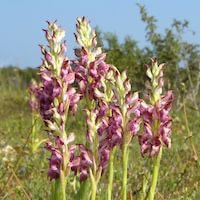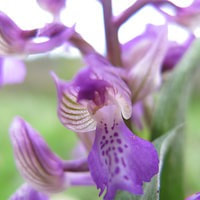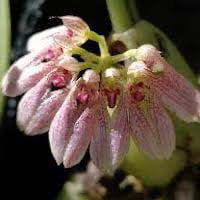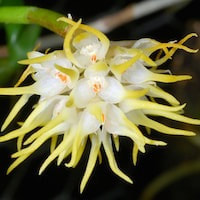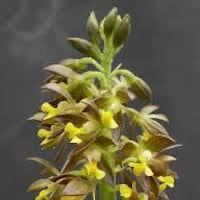MOR6- Men's Oriental 6, - I am the captain now
|
Native Singaporean Orchid notes: Coelogyne Zurowetzii
Coelogyne zurowetzii is an epiphytic orchid thriving in Singapore, Kalimantan, and Sabah Borneo's heath and freshwater swamp forests at elevations of 400-700 meters. Known for its spicy fragrance with hints of cloves, lilac, and candy, it's favored in perfumery. This orchid, distinct for its aromatic profile, was chosen for a Team Building Perfume Workshop in Oriental 6 (Men). Cultivating and conserving Coelogyne zurowetzii is crucial to sustain its role in perfumery. Participants explore its fragrance to create personalized perfumes, enhancing their sensory and creative experiences.
|
Therapeutic Orchid notes:
|
Anacamptis coriophora
Anacamptis coriophora, commonly called the Bug orchid, stands out for its small, green to deep wine-red flowers characterized by fused tepals forming a hood-like structure above the column. This orchid species contains p-hydroxybenzyl alcohol, known as an aglycone of gastrodin, a phenolic compound with potential health benefits. Research suggests gastrodin and p-hydroxybenzyl alcohol may enhance memory processes in rats, making them promising in neuroscience. Additionally, p-hydroxybenzyl alcohol shows skin whitening effects by inhibiting tyrosinase, relevant for cosmetic applications, although further research is needed to explore these potentials fully. |
|
Anacamptis morio ssp. picta
Anacamptis morio ssp. picta, a subspecies of the Green-winged orchid, is found in regions like Iran, where its tubers are used to make salep, a traditional Middle Eastern health drink. Salep, rich in starch and nutrients, is valued for its energy-boosting and digestive benefits. However, overharvesting of orchid tubers for salep has endangered many orchid species, including Anacamptis morio, leading to their protection in Europe. Conservation efforts are crucial to preserve these orchids and their habitats for future generations. |
|
Bulbophyllum andersonii also Cirrhopetalum andersonii and Cirrhopetalum henryi Rolfe
Bulbophyllum andersonii, also known as Cirrhopetalum andersonii, is a striking orchid native to regions in China, Vietnam, Myanmar, India's Sikkim, and parts of the Himalayas. It blooms from February to October in China and September to October in Sikkim. In traditional Chinese medicine, the whole plant, known as Yipicao, is used to treat various ailments such as rheumatism and coughs, and to improve blood circulation. B. andersonii contains bioactive compounds like cirrhopetalin and bibenzyl derivatives, which contribute to its medicinal properties. Research continues to explore its therapeutic potential, emphasizing the need for conservation to protect this orchid in its natural habitats. |
|
Bulbophyllum odoratissimum
Bulbophyllum odoratissimum, known by multiple Chinese names such as Mihuashidou Lan and Xiaohaoshi Ganlan, is an orchid species found across Asia, including China, Tibet, Nepal, Bhutan, and Myanmar, with varying flowering periods from April to September. In traditional medicine, it's used for treating fractures by applying its powder mixed with wine, and for pulmonary tuberculosis and hernia pain with specific herbal mixtures. Chemical studies have identified compounds like phenanthraquinone and flavonoids in Bulbophyllum odoratissimum, showing potential anti-tumor effects against human cancer cells. Scientific research continues to explore its medicinal properties, emphasizing the need for conservation to safeguard this orchid species and its habitats. |
|
Calanthe mannii Hook
Calanthe mannii Hook, commonly called Small Flowers Prawn Spine Orchid, is a terrestrial orchid native to Asia, including China, Japan, Korea, and Vietnam. In traditional Chinese medicine, it's used to treat conditions like stomach heat, scrofula (swollen lymph nodes), and abscesses. The orchid features pseudobulbs and lanceolate leaves, with delicate flowers resembling prawn spines in colors ranging from white to pink and purple. Despite its traditional uses, scientific evidence supporting its medicinal efficacy is limited, necessitating further research. Conservation efforts are crucial due to threats like habitat destruction and over-harvesting, ensuring the preservation of Calanthe mannii and its natural environment. |
Other scent note
ambergris, black pepper, poppy
Scentopia Library Reference ingredient
Oregano - Check details at Scentopia's scent library
Download the guided mediation that works best with this Orchid fragrance oil
| men_oriental_essential_oil_orchi_00006.mp3 | |
| File Size: | 124715 kb |
| File Type: | mp3 |

